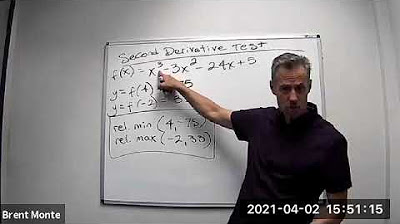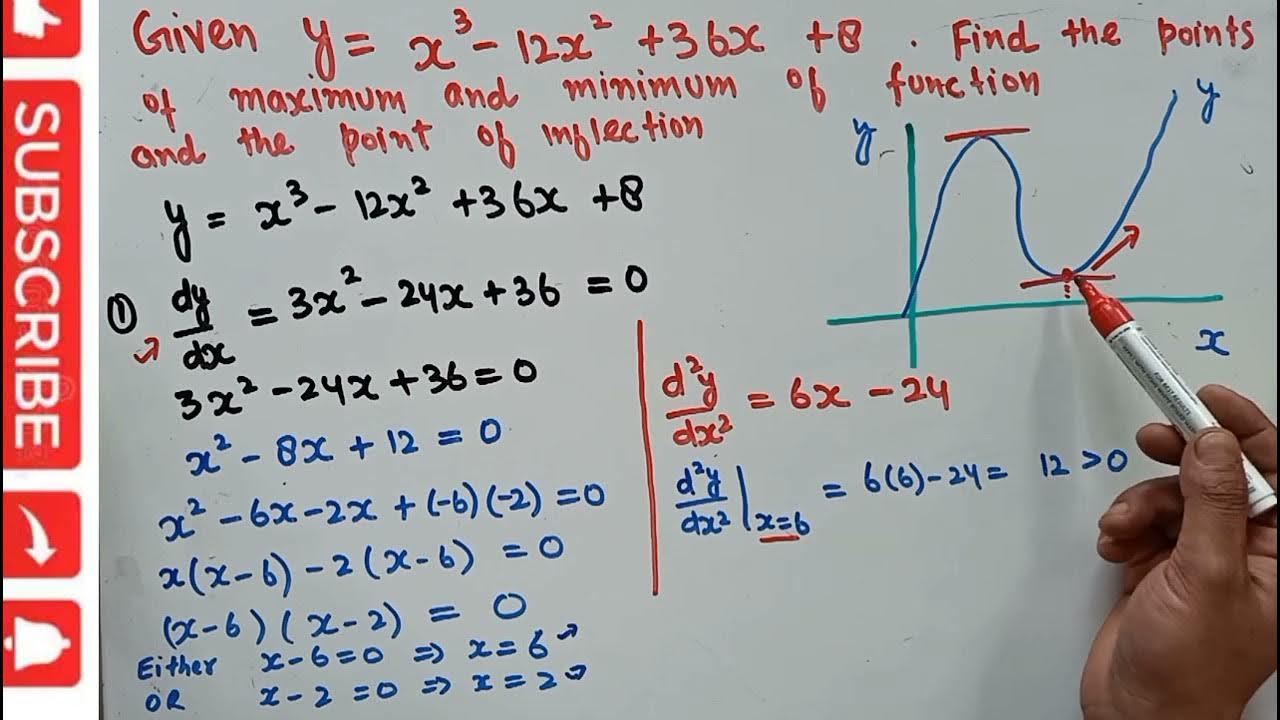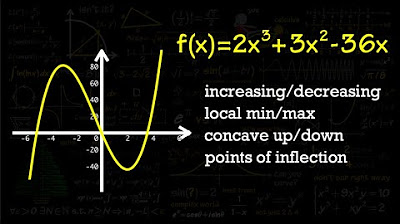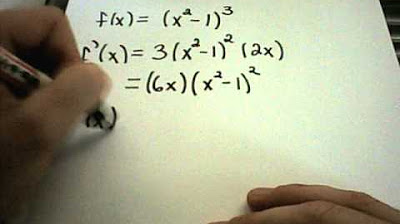First Derivative Test to find increasing/decreasing and relative max/min
TLDRIn this engaging video, Professor Money dives into the concept of determining the behavior of a function, specifically identifying whether it is increasing or decreasing and locating any relative maximum or minimum values, also known as local extrema. The focus is on the function f(x) = x^2 - 2x + 4. The professor explains the importance of the first derivative in understanding the rate of change and the slope of the tangent line. By setting the first derivative to zero and solving for critical values, it is determined that x = -2 is the only critical point. Using a sign chart and test numbers, the function's behavior is deduced: it decreases from negative infinity to x = -2 and increases from x = -2 to infinity. The video concludes with the discovery of a relative minimum at the point (-2, -6), which is also the vertex of the parabola. The presentation is designed to encourage students to practice these methods to enhance their understanding of calculus.
Takeaways
- 📈 To determine if a function is increasing or decreasing, look at the first derivative; it represents the rate of change or the slope of the tangent line.
- 🔢 The first derivative of the function '2x + 4' is set to zero to find critical values, which indicate potential changes in the function's direction.
- 🔎 Solving '2x + 4 = 0' yields x = -2, the only critical value, splitting the number line into intervals: (-∞, -2) and (-2, ∞).
- 🧮 Use test values within these intervals to determine the sign of the first derivative and hence the behavior of the function: decreasing or increasing.
- 📉 In the interval (-∞, -2), the derivative is negative, indicating that the function is decreasing.
- 📈 In the interval (-2, ∞), the derivative is positive, showing that the function is increasing.
- 🏆 At x = -2, the function transitions from decreasing to increasing, creating a relative (local) minimum point there.
- 📌 The relative minimum of the function is at the point (-2, -6), found by substituting x = -2 into the original function equation.
- 🚫 There is no relative maximum as the function increases indefinitely beyond x = -2 without turning back down.
- 🎓 Practice finding where graphs increase and decrease and their extrema will become quicker and more intuitive.
Q & A
What does the first derivative of a function indicate?
-The first derivative of a function indicates the rate of change of the function or the slope of the tangent line at a point on the function.
How do you determine if a function is increasing or decreasing?
-To determine if a function is increasing or decreasing, you look at the sign of its first derivative. If the derivative is positive, the function is increasing; if it's negative, the function is decreasing.
What is a critical value in the context of calculus?
-A critical value is a point on the x-axis where the derivative of a function is either zero or undefined. It's where the function can potentially change from increasing to decreasing or vice versa.
What is the purpose of setting up a chart of signs?
-A chart of signs is used to determine the intervals where the derivative is positive or negative. This helps to identify where the function is increasing or decreasing.
What is the critical value for the function f(x) = 2x + 4?
-The critical value for the function f(x) = 2x + 4 is x = -2, which is found by setting the first derivative equal to zero and solving for x.
How do you find out if there is a relative maximum or minimum?
-You can determine if there is a relative maximum or minimum by analyzing the change in the sign of the derivative around a critical value. If the sign changes from positive to negative, there is a relative maximum; if it changes from negative to positive, there is a relative minimum.
What is the relative minimum value of the function f(x) = 2x + 4 at x = -2?
-To find the y-value of the relative minimum, plug the critical value x = -2 into the original function. For f(x) = 2x + 4, plugging in -2 gives f(-2) = 2(-2) + 4 = -4 + 4 = 0, but the actual y-value is found by plugging into the original function, which gives f(-2) = (-2)^2 + 4(-2) - 2 = 4 - 8 - 2 = -6.
Why is there no relative maximum for the function f(x) = 2x + 4?
-There is no relative maximum for the function f(x) = 2x + 4 because the function continues to increase indefinitely as x goes to infinity, without any change in the direction of the slope.
What is the vertex of the parabola represented by the function f(x) = 2x + 4?
-The vertex of the parabola represented by the function f(x) = 2x + 4 is at the point (-2, -6), which is the relative minimum point of the function.
How can calculus help in finding relative maxima of any function?
-Calculus allows us to find relative maxima (and minima) of any differentiable function by analyzing the first derivative and its critical points, which can reveal the function's behavior and turning points.
What is the advice given for students struggling with calculus?
-The advice given is to practice and not to get discouraged. It is emphasized that with perseverance and practice, understanding calculus concepts will come more quickly.
Outlines
📈 Understanding Function Behavior with Derivatives
Professor Money introduces the concept of using the first derivative to determine whether a function is increasing or decreasing. The first derivative represents the rate of change or the slope of the tangent line. By setting the derivative equal to zero, we find critical values where the function's behavior might change. In this case, the derivative is 2x + 4, and solving it yields x = -2 as the only critical value. A chart of signs is used to test intervals around the critical value to determine the sign of the derivative and hence the function's increasing or decreasing nature. The function is found to be decreasing from negative infinity to x = -2 and increasing from x = -2 to infinity. The video also identifies a relative minimum at x = -2 by observing the graph's behavior and calculating the y-value at this point, which is -6, making the relative minimum the point (-2, -6).
Mindmap
Keywords
💡Increasing Function
💡Decreasing Function
💡First Derivative
💡Critical Value
💡Relative Maximum
💡Relative Minimum
💡Local Extrema
💡Tangent Line
💡Rate of Change
💡Chart of Signs
💡Vertex of a Parabola
Highlights
The first derivative of a function indicates whether the function is increasing or decreasing by showing the rate of change or slope of the tangent line.
Setting the first derivative equal to zero helps find critical values where the function's behavior can change.
The function given is f(x) = 2x^2 + 4x, and its first derivative is f'(x) = 4x + 4.
By solving f'(x) = 0, we find the critical value x = -2.
A chart of signs is used to test intervals around the critical value to determine the function's behavior.
Choosing test numbers within the intervals, such as x = -3 for the interval (-∞, -2), helps in understanding the function's trend.
For x = -3, f'(x) = -2, indicating the function is decreasing in the interval (-∞, -2).
Choosing x = 0 as a test number for the interval (-2, ∞), we find f'(x) = 4, indicating the function is increasing.
The function is increasing on the interval (-2, ∞) and decreasing on the interval (-∞, -2).
The graph of the function has a relative minimum at x = -2, as indicated by the change from decreasing to increasing behavior.
There is no relative maximum because the function continues to increase indefinitely.
The y-value of the relative minimum is found by substituting x = -2 into the original function, not the derivative.
The calculated y-value at the relative minimum is -6, giving the point (-2, -6).
The vertex of the parabola can be found using calculus, which is applicable to any function, not just parabolas.
Practicing these methods helps students become quicker at identifying increasing/decreasing intervals and extrema.
Encouragement is given to students to not get discouraged and to keep practicing calculus.
The video ends with a call to action for likes and subscriptions to help other students find and benefit from these educational resources.
Transcripts
Browse More Related Video

Second Derivative Test to find relative maximums and minimums (extrema)

Analyzing a function with its derivative | AP Calculus AB | Khan Academy

Maxima , minima and point of inflection

2023 AP Calcululs AB & BC FRQ #4

Increasing/Decreasing, Concave Up/Down, Inflection Points

Increasing/Decreasing + Local Max and Mins using First Derivative Test
5.0 / 5 (0 votes)
Thanks for rating: